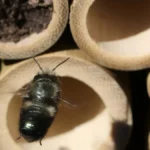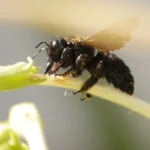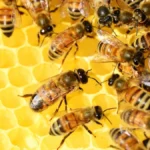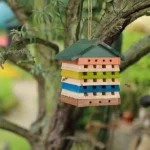People often ask about the types of bees that exist. The simple answer is there are a really really large number of bee species – at least 20 000 with more than 4000 in the US. In this article, we will delve into more depth on this fascinating topic and help you understand the broad groups of bees, and how important each group is to keep our world going and your food interesting.
Where Did Bees Come From?
Bees evolved from some ancient wasp that was a predator. Somewhere along the evolutionary footpath, bees shifted from eating insect protein to pollen protein. In this way, some of the most efficient pollinators on the planet came into existence, and the result is there are many types of bees.
Gender In Bees
In mammals like ourselves, gender is determined by X and Y chromosomes. If you have two X chromosomes, you are biologically female. If you have an X and a Y chromosome, you are biologically male. The topic of gender these days is a bit of slippery slope, so let’s move swiftly on from mammals, some of whom have complex brains and feelings, to the bees.
Bees have a system known as haplodiploidy, which determines gender. A fertilized egg is female, and an unfertilized egg is male.
What Are The Different Types Of Bees?
This is a question that can be answered by a medium-sized library if we go into too much detail. Bees are a very varied group of insects. What we need to do here is really just to give you a very broad overview of what the different major types of bees are. If any of these grab your fancy, you can read further.
Solitary Bees
Solitary bees make up the vast majority of bee species. These are bees, as the name says, solitary. This means that they do not cooperate in any way to raise their young. Girl bee meets boy bee. They mate. Boy bee dies. Girl bee carts pollen and nectar from flowers and makes some sort of little nest, and lays eggs in here. Eggs hatch. Larvae develop, pupate, hatch, and the process repeats.
Leaf Cutter Bees
These bees, as their name suggest, leaf cutter bees cut little pieces of leaves. They roll these into cigar-like shapes and stuff them in hidden places – these can range from cracks in rocks, walls, trees, to rotten wood or bark.
I have had great luck with keeping various species of these bees by finding a piece of softwood and drilling a series of 0,22-inch holes in the wood and hanging this under the eaves of my house. You can purchase premade nests which will attract these bees such as this model.

Leafcutter bees are shy little creatures, and you will often hardly even know they are around. If you want to read up a little more about these little bees this is a nice summary.
Mason Bees
These bees, as the name suggests, make masonry. They make nests out of a mud-like substance which they will conceal in cracks, holes, crevices, and various other concealed places.
Much like the leafcutter bees, the females mate, then cart nectar and pollen to their little mud nests that they make. They provision tubes with food, lay an egg, and then start to provision the next tube. Typically, they lay female eggs first and then male eggs towards the end of the crevice.
I have made little nests for these bees by cutting reeds and putting them in bottles, an old cupboard, and even a birdhouse. Tie bundles of bamboo the thickness of a finger and hang these from under the eaves. You can also buy a premade nesting site.

I love mason bees just because they are some of the most colorful creatures I have ever seen. They can range from beautiful blues and greens in North America, to things that look like an LSD trip in India. Incredible colors.
Carpenter Bees
These bees, the so-called Xylocopa (woodcutters in Greek) are a big group of bees that make holes in wood, and plant products. The females provision these holes with pollen and nectar balls and lay eggs on them.
The carpenter bees are my favorite pollinators. These can get to be absolutely huge bees and when they land on a flower they more than buzz pollinate it. I have seen carpenter bees land on flowers and blow the petals off the flower with their strong wings. Much like a helicopter landing on a dusty field, the carpenter bee lands on a flower and just blows pollen all over.
The carpenter bees can sometimes be a bit of a problem when they burrow into structural timber – I have on many occasions been called in to remove these bees. Normally, if the timber is attractive to them it means it is rotten. It is relatively easy to deter them from timber by painting it or lining it with metal sheeting or plastic.
Carpenter bees are really easy to provide nesting sites for. I always keep a few dead logs wedged in trees – softwood is best. Drill a few starter holes in the logs and the bees will move in. You can also use bundles of bamboo, or even buy a nest such as this one that will attract all sorts of solitary bees.

Bumble Bees
These bees make nests and have a social structure. You can read more about them here.
Honey Bees
Our good friends. These bees have an advanced social structure with a queen, workers, and drones. They make nests in cavities (Apis mellifere and Apis cerana) or hanging from trees and rocks.
I have had the pleasure of watching Apis dorsata, the giant honeybee, nesting in trees in the East. Sometimes you will see a few hundred hives nesting in a tree. These bees build a huge single comb hanging from a branch – this comb can be a few yards long and a few yards down.
Hives can have hundreds of thousands of bees in them. As birds fly past the bees that cover the combs all orientate instantly at the bird and buzz. It is the weirdest thing watching an entire hive flash like this.
When I was visiting a molasses distillery on the banks of the Ganga, a monkey disturbed a swarm of these bees, and twenty people got so badly stung they ended up in hospital. These bees sting like professionals. They know how to make you feel pain.
This is a broad summary of the most common types of bees you will see. There are more weird and wonderful bees, and even cuckoo bees, that parasitize other bees and so on. We hope you found this interesting, and please set up a solitary beehive. And encourage your friends to as well. We need these little friendly bees to make our food fun.
Read more about: Do Bees See In Color?
Bee Types FAQs
How many species of bees are there?
There are over 20,000 known species of bees, with more than 4,000 species native to the U.S. alone.
What is the difference between solitary and social bees?
Solitary bees, like mason and carpenter bees, do not form colonies. Each female builds and provisions her own nest. Social bees, such as honey bees and bumblebees, live in colonies with a division of labor between queens, workers, and drones.
What are honey bees known for?
Honey bees are known for their advanced social structures, large colonies, and ability to produce honey and wax. They play a crucial role in pollinating many agricultural crops.
What are mason bees and why are they important?
Mason bees are solitary bees that build their nests out of mud. They are efficient pollinators, particularly for fruit trees, and can pollinate at a much faster rate than honey bees.
How do carpenter bees differ from other bees?
Carpenter bees are large bees that burrow into wood to create nests. While they are excellent pollinators, they can sometimes cause damage to wooden structures when nesting.
Why are bumblebees considered social bees?
Bumblebees live in small colonies and have a queen, workers, and drones. They build nests in the ground or in other protected areas and are key pollinators, especially in cooler climates.
What are leafcutter bees and how do they build nests?
Leafcutter bees cut small, circular pieces from leaves to construct their nests. They often nest in pre-existing cavities such as cracks in wood or walls and are known for their gentle nature and efficient pollination skills.
What role do solitary bees play in pollination?
Solitary bees, which make up the majority of bee species, are crucial pollinators. Each female bee gathers pollen and nectar to provision her nest, significantly aiding in plant pollination.
Can carpenter bees harm buildings?
Carpenter bees can cause structural damage to wood by boring holes for their nests. However, they typically target untreated or rotting wood, and preventive measures like painting or using hardwood can deter them.
Why are bees important to our ecosystem?
Bees are essential pollinators for many plants, including food crops. Without bees, many of the fruits, vegetables, and nuts we rely on would struggle to reproduce, severely impacting food supply and biodiversity.

Dr. Garth A. Cambray is a Canadian/South African entrepreneur and beekeeper with 28 years of experience in apiculture and specializes in adding value to honey. His Ph.D. research developed a new advanced continuous fermentation method for making mead that has resulted in a number of companies globally being able to access markets for mead. His company, Makana Meadery, exports honey mead to the USA where it is available to discerning connoisseurs. He has also developed technologies to commercially manufacture organic honey vinegar in Zambia for export globally. He holds a few patents globally in the ethanol industry and believes in technology and knowledge transfer for human development and environmental sustainability. One of his proudest achievements is the fact that the wind farm he started at one of his old apiary sites has essentially made his hometown carbon neutral.






